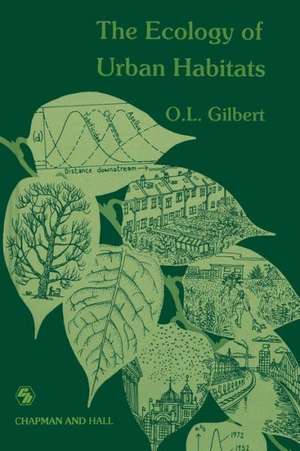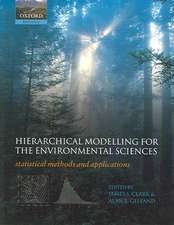The Ecology of Urban Habitats
Autor Oliver Gilberten Limba Engleză Paperback – 20 sep 2011
Preț: 644.63 lei
Preț vechi: 758.38 lei
-15% Nou
Puncte Express: 967
Preț estimativ în valută:
123.37€ • 127.44$ • 102.67£
123.37€ • 127.44$ • 102.67£
Carte tipărită la comandă
Livrare economică 26 martie-09 aprilie
Preluare comenzi: 021 569.72.76
Specificații
ISBN-13: 9789401068550
ISBN-10: 9401068550
Pagini: 384
Ilustrații: XII, 370 p.
Dimensiuni: 155 x 235 x 20 mm
Greutate: 0.54 kg
Ediția:Softcover reprint of the original 1st ed. 1989
Editura: SPRINGER NETHERLANDS
Colecția Springer
Locul publicării:Dordrecht, Netherlands
ISBN-10: 9401068550
Pagini: 384
Ilustrații: XII, 370 p.
Dimensiuni: 155 x 235 x 20 mm
Greutate: 0.54 kg
Ediția:Softcover reprint of the original 1st ed. 1989
Editura: SPRINGER NETHERLANDS
Colecția Springer
Locul publicării:Dordrecht, Netherlands
Public țintă
ResearchCuprins
Preface.- 1 Introduction.- 2 Characteristics of urban flora and fauna.- 2.1 Proliferation of introduced species.- 2.2 Severe disturbance.- 2.3 Increased opportunities for dispersal.- 2.4 Habitat diversity.- 2.5 Taxonomic and evolutionary aspects.- 2.6 Vertebrates.- 2.7 Invertebrates.- 2.8 Planted vegetation.- 2.9 Historical factors.- 3 The urban climate and air pollution.- 3.1 Climate.- 3.2 Air pollution.- 4 Soils in urban areas.- 4.1 The classification of urban soils.- 4.2 Conspectus.- 4.3 Characteristics of urban soils.- 4.4 Brick rubble.- 4.5 Topsoiled sites.- 5 Vegetation dynamics.- 5.1 Ecological change as greenfield sites become developed.- 5.2 Ecological change as urban land is recycled.- 5.3 Postdevelopment.- 5.4 Discussion.- 6 Urban commons.- 6.1 Plants.- 6.2 Animals.- 6.3 Research opportunities.- 7 Industrial areas.- 7.1 Raw materials.- 7.2 Buildings, structures, hard landscapes.- 7.3 Energy aspects.- 7.4 Stores and warehouses.- 7.5 Solid waste material.- 7.6 Modern trends.- 8 Railways.- 8.1 The permanent way.- 8.2 Sidings.- 8.3 Brickwork and masonry.- 8.4 Verges.- 8.5 Boundary features.- 9 Roads.- 9.1 Road design.- 9.2 Exhaust emissions.- 9.3 De-icing salt.- 9.4 Traffic stress.- 9.5 Street trees.- 9.6 Grass verges.- 9.7 Animals.- 10 City centres.- 10.1 Animals.- 10.2 Vegetation.- 10.3 Interactions.- 11 City parks.- 11.1 Habitats within a park.- 11.2 Grassland.- 11.3 Growth retardants and herbicides.- 11.4 The changing wild flora of parks.- 11.5 Lakes.- 11.6 Mammals.- 11.7 Birds.- 11.8 Invertebrates.- 12 Allotments and leisure gardens.- 12.1 Background.- 12.2 Cultivated plots.- 12.3 Secondary successions.- 12.4 Birds.- 12.5 Supplementary habitats.- 12.6 Fostering wildlife on allotments.- 13 Cemeteries.- 13.1 Background.- 13.2 Structure planting.- 13.3 Shrubs.-13.4 The ground layer.- 13.5 Grave plots.- 13.6 Relic communities.- 13.7 Succession.- 13.8 Management options.- 14 Gardens.- 14.1 Vegetation.- 14.2 Animals.- 14.3 Discussion.- 15 Rivers, canals, ponds, lakes, reservoirs and water mains.- 15.1 Urban hydrology.- 15.2 Rivers.- 15.3 Canals.- 15.4 Ponds, lakes, reservoirs and water mains.- 16 Woodland.- 16.1 The archaeology of a small urban wood.- 16.2 Ancient seminatural woodland.- 16.3 Plantations on the site of ancient woodland.- 16.4 Spontaneous recent woodland.- 16.5 Plantations.- 16.6 Birds.- 17 Living with wildlife.- 17.1 The aesthetic conflict.- 17.2 Social considerations.- 17.3 Design and management.- 17.4 Benefits for all.- References.














